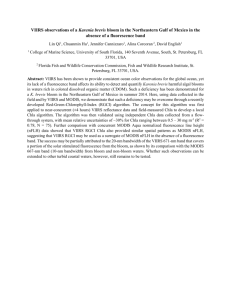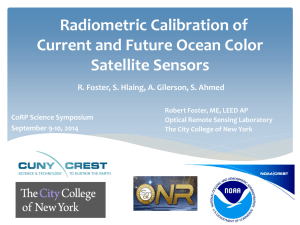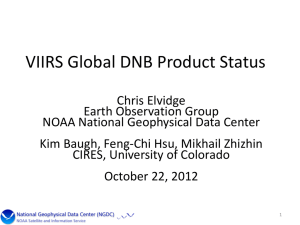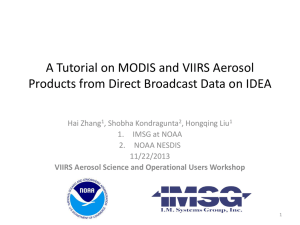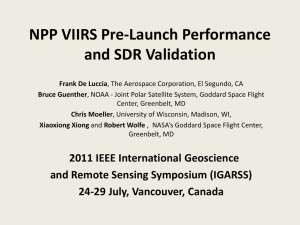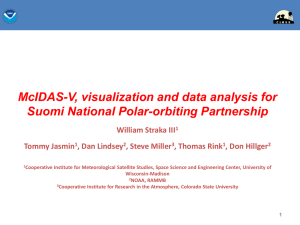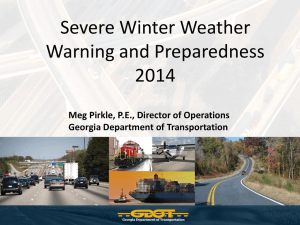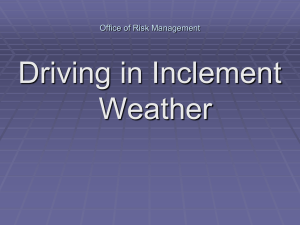4-ROMAN_IGARSS11
advertisement
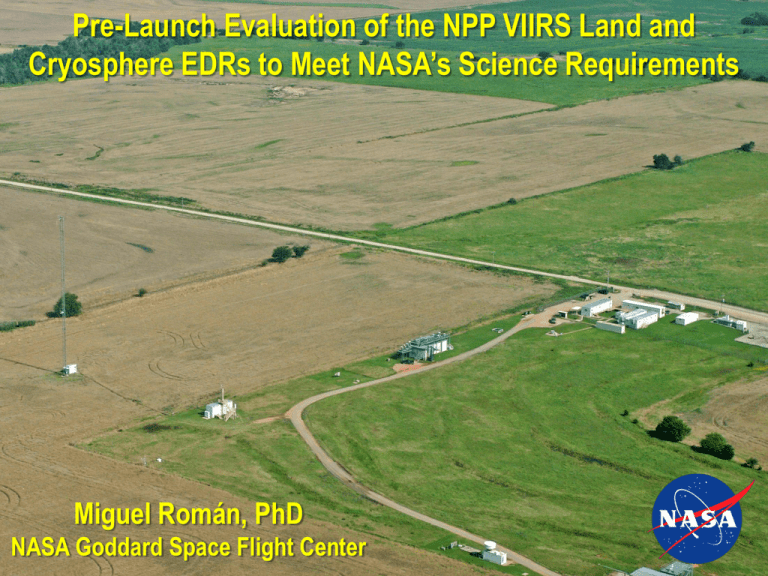
Pre-Launch Evaluation of the NPP VIIRS Land and Cryosphere EDRs to Meet NASA’s Science Requirements Miguel Román, PhD NASA Goddard Space Flight Center with contributions from the VIIRS Land Team#: Chris Justice, Ivan Csiszar, Jeff Privette, Mark Friedl, Chengquan Huang, Jerry Zhan, Louis Giglio, Pierre Guillevic, Crystal Schaaf, Dorothy Hall, Tomoaki Miura, Jeff Key, Alexei Lyapustin, Jim Maslanik, George Riggs, Peter Romanov, Igor Appel, Eric Vermote, Wilfrid Schroeder, Robert Wolfe, and Yunyue Yu #Support for the activities underpinning this talk was provided by the JPSS Data Products and Algorithms Division and NASA’s Science Data Segment via the Land PEATE (Product Evaluation and Algorithm Test Element). NPP Cal/Val Phases Build Team Sensor Characterization Estab. Sensor Stability NPP Launch Post-Launch Plan Dev. Late 2011 SDR Validation SDR/EDR Alg. Tuning Resource ID & Development Cal/Val Tool Development Sens or Charar. &Calibration PRE-LAUNCH LAUNCH Alg. Assessment & Verifications Quick-Look Analysis SDRs/EDRs EOC (1) Land Surface Temperature (LST) (2) Surface Type (7) Albedo (3) Active Fires (ARP) (8) Vegetation Index (4) Surface Reflectance (9) Snow Cover/Depth (5) Ice age (10) Ice Concentration (6) Ice motion (11) Ice Surface Temperature Key EDR Validation Mission Integration Product Ops Viability ICV EDR Validation NPP-VIIRS Land/Cryosphere Products Monitor Sensor Stability LTM Land Team Roles and Focus Areas: • The NPP Land Cal/Val plan was generated jointly by the NASA and NOAA team members. • NOAA is focused on the Cal/Val for the IDPS operational algorithms. • NASA is focused on Cal/Val for the long-term satellite data record. • Pre-launch Cal/Val activities are for testing both the operational and long-term aspects of the system as a whole, including NASA and NOAA infrastructure (e.g., CLASS, GRAVITE, and NASA’s PEATEs). NPP Land PEATE • Managed as part of NASA’s NPP Science Data Segment (SDS). • Objective: To run the VIIRS Land EDRs, IPs, and ARPs, enabling the science team to evaluate them to those from MODIS and the equivalent science algorithms for VIIRS. • Actively involved in planning and coordination of NCT3/4 testing and NPP Cal/Val rehearsal phases. Data Continuity will require Algorithm Continuity • The MODIS Land products have had significant uptake by both the science and applications communities. • There is some expectation from these communities that the data stream will continue with VIIRS. • The science team has been providing input to the JPSS program for potential improvements in EDR specifications. The following is a summary of the VIIRS Land Cal/Val and Science Team’s findings to date (July, 2011) with respect to the utility of the Land and Cryosphere EDRs to meet NASA’s science requirements. Land Surface Temperature (LST) EDR Description: Provides land surface skin temperature at the satellite overpass time under cloud-free conditions. Retrieval Strategy: Multichannel Linear Regression Approach (Atmospheric absorption is corrected using signal differences between the channels in infrared band; a linear regression form is derived from linearization of the radiative transfer process). Surface Type Dependency (Coefficients of the regression algorithms are surface type dependent with the IGBP types.) Current Challenges: LST EDR does not provide dynamic land surface emissivity per the current MODIS “day-night” algorithm. This is a valuable product and should be continued in the JPSS era. Apparent Emissivity Apparent LST Observed LST is angle dependent LST Retrieval from SEVIRI, as proxy of VIIRS VIIRS LSTs from MODIS as proxy See Bob Yu’s talk: (WE3.T09 – 7/27) VIIRS Surface Type EDR • EDR description: Each pixel labeled with one of 17 IGBP Surface Types. • Current Retrieval Strategy: Supervised classification based on the C5.0 decision tree algorithm. Uses annual trajectories of metrics based on VIIRS NDVI & TIR observations. Exploits a site database of known surface types for decision tree estimation. Advantages and Challenges: The EDR is expected to meet its target requirement, though with relatively lower classification accuracies for less uniform and hard to separate classes. Annual change products designed to identify potential change regions could be valuable to the broad science communities working on land cover, ecosystems, and terrestrial carbon budgets. from Zhan, Huang, and Friedl Surface Albedo EDR • Description: Provides broadband surface albedo (0.3-5.0µm) on a daily basis under cloud-free conditions. • Retrieval Strategy: Single-day BPSA (Uses TOA radiances and pre-computed radiative transfer model information) Multidate DPSA (Uses MODIS BRDF/Albedo heritage) • Current Challenges: Both Climate and NWP models call for a representation of the surface radiation in terms of at least PAR (0.3-0.7µm) and NIR (0.7-5.0µm) radiation. MODIS Proxy (PGE 363 - 2007177) Shortwave Broadband White-Sky Albedo MODIS 0.05deg WSA 2007-177 (PAR) MODIS 0.05deg WSA 2007-177 (NIR) from C. Schaaf Vegetation Index EDR MODIS proxy TOA-NDVI & TOC-EVI (2007-177) • Product Description: Provides the Normalized Difference Vegetation Index (NDVI) and the Enhanced Vegetation Index (EVI) at 375 m on a daily basis. • Retrieval Strategy: – The NDVI derived from “Top-of-the-Atmosphere (TOA)” reflectance. – The EVI derived from “Top-of-the-Canopy (TOC)” reflectance and based on a 3-band equation. TOA-NDVI • Current Challenges: – Continuity: The VIIRS NDVI (TOA) will inherently be different from the MODIS NDVI (TOC). The VIIRS EVI equation will be different from the MODIS EVI equation and will require a correction factor for continuity. – Performance: The TOA-NDVI specs were determined for “surface + atmosphere” signals. EVI noise will be influenced by atmospheric corrections (aerosols) and by VIIRS blue band noise. – Algorithm: Temporal compositing will not be part of the IDPS operational algorithm. TOC-EVI -0.2 0 0.25 0.5 0.75 1.0 from T. Miura Surface Reflectance IP • Description: Provides spectral surface reflectance under cloud-free conditions. APU (GSFC Site, 2007-193) • Ancillary Data: VIIRS Cloud Mask, Aerosol model and AOT; NCEP: Ozone, Column Water Vapor, DEM, and Land-Water Mask • Algorithm Assumptions: MODIS heritage (MOD09) uses Lambertian approximation. VIIRS Surface Reflectance ASRVN VIIRS Surface Reflectance Accuracy, Precision, and Uncertainty (APU) Metrics Positive biases (≥0.02) are due to the much higher AOT retrieval in VIIRS, compare to AERONET measurements. If biases in the VIIRS AOT retrieval are high, the effect on SR will be largest at shortest wavelengths (VIS-NIR). from Wang and Lyapustin VIIRS SDR Geolocation • Description: Ellipsoid and terrain corrected geolocation for I, M and D/N bands. • Retrieval Strategy: Algorithm uses detailed instrument geometric model, on-board navigation and digital terrain model Global set of ground control points are used to update instrument and spacecraft geometric parameters to achieve sub-pixel geometric accuracy Landsat TM/ETM Image chips are used for Ground control points • Current Challenges: Removing on-orbit thermally induced pointing changes (MODIS approach will be used). > 1200 Ground control points from R. Wolfe (see Mash’s talk – FR1.T05 7/29) VIIRS Ice Characterization EDR • Description: An ice age classification for the categories: Ice -free, New/Young Ice (less than 30 cm thickness), and All Other ice. Freshwater ice is not included. • Retrieval Strategy: • An energy budget approach is used to estimate sea ice ice thickness. • Daytime and nighttime algorithms use different approaches. • While the algorithm generates age categories, it actually uses temperature, reflectance and estimated thickness as proxies for age (i.e., age is not calculated directly). • Ice concentration is a intermediate product (IP) in the ice characterization EDR. • Current Challenges: EDR is sensitive to errors in the depth of the snow and the surface albedo. The uncertainty of the product is highest for nighttime retrievals. An alternative model is being investigated. Examples of ice thickness (left) and ice age (right) over the Arctic. J. Key et al. VIIRS Ice Surface Temperature EDR • Description: The surface (skin, or radiating) temperature over snow and ice. • Retrieval Strategy: • The algorithm incorporates an empirical correction for water vapor absorption. • It is a split-window approach similar to that used for sea surface temperature (SST). MODIS VIIRS The surface temperature over part of the Antarctic ice sheet and surrounding sea ice derived from MODIS data with a VIIRS-like algorithm. • Current Challenges: Based on the performance of its heritage AVHRR and MODIS algorithms, the IST EDR should meet its accuracy specification. • For climate studies, it is useful to treat the pack ice IST, coastal ice IST, and land IST as a single data set. This could be addressed by refining the areas for which IST is calculated. J. Key et al. VIIRS Snow Cover EDR • Description: Provides Binary Snow Cover and Snow Cover Fraction under cloudfree conditions. • Retrieval Strategy: Binary Snow Cover (Uses TOA radiances and the Normalized Difference Snow Index (NDSI) and the VIIRS cloud mask) Snow Cover Fraction (Uses 2x2 aggregation of the binary snow cover) • Current Challenges: Fractional Snow Cover and Daily Snow Albedo datasets are crucial for monitoring the snowmelt process and surface energy balance at midto high latitudes and mountainous areas. NPP_SRFLIIP_L2, surface reflectance Land PEATE , VIIRS PROXY DATA, 2003-033 NPP_VSCM_L2, Binary Snow Cover, Land PEAT, VIIRS PROXY DATA, 2003033 snow-red, snow-free-green, not snow-blue NPP_VSCD_L2, Snow Cover Fraction, Land PEAT, VIIRS PROXY DATA, 2003033 snow-red, snow-free-green, not snow-blue from J. Key, P. Romanov, and D. Hall Active Fires EDR AVAFO_npp: 12:25:56 – 12:30:11 VIIRS • Description: Geolocation of pixels in which actively burning fires are detected • Retrieval Strategy: MODIS Collection 4 hybrid thresholding and contextual algorithm (2003). On-board aggregation of saturated pixels. • Current Challenges: MYD14_aqua: 12:25:00 – 12:30:00 MODIS Examples of NPP VIIRS proxy and corresponding Aqua MODIS active fire data in East-Central Africa on September 6, 2002 VIIRS proxy tests have shown that the ARP produces false fires over arid surfaces. ARP output lacks the contextual fire mask and fire radiative power (FRP) data layers that are standard components of current and forthcoming active fire data sets (e.g., GOES, and SEVIRI). The science community addressing global fire emissions, air quality, aerosol studies, and ecosystem processes are currently utilizing (and expect data continuity for) the MODIS Burned Area Product. L. Giglio (UMCP ) and I. Csiszar (NOAA) Aircraft Campaigns in Support of VIIRS Cal/Val Efforts … to Global Land Products From Sensor Data Records… (AMS/Ikhana) IFOV: 2.5 mrad FOV: 85.9˚ GIFOV: 50 m Simulated Bands: - ETM+ B1-B4 - MODIS B27 - VIIRS M15-M16 - Airborne simulators support prototyping and testing of Level 1 VIIRS Sensor Data Records (SDRs). - Provide verification of sensor calibration and stability during ICV and LTM. Active Fires + Burned Area (CAR/P3-B) Simulated Bands: - ETM+ B1-B4 - MODIS B1,B2,B3,B5 - VIIRS I2, M3, M5, M7-8 IFOV: 17.5 mrad FOV: 190.0˚ GIFOV: 4.0-500 m Surface Reflectance, VI, BRDF, and Albedo - Development and testing of standard products (L2+). Provides critical in-situ data for multi-sensor 17 validation and intercomparison studies . Campaign Efforts (LST-EDR) Validation strategy based on: •NOAA’s observations networks •physically-based framework for scaling issues Bondville, IL Aircraft flights to characterize LST spatial variability Installed Pair (14) Installed Single (100) Challenges: Chestnut Ridge, TN UTSI aircraft Automatic validation using the USCRN sites from P. Guillevic (NOAA) VIIRS Land Team Findings 1. If all the Land and Cryosphere EDRs are to serve the needs of the science community, a number of changes to several products and the IDPS algorithm processing chain will be needed. 2. Other products will also need to be added to the VIIRS Land product suite to provide continuity for all of the MODIS land data record. 3. With the absence of an AM orbit, it has yet to be determined whether there is sufficient improvement from combining the VIIRS with the METOP AVHRR (1km), which provides AM data, albeit at 09:30. 4. As demonstrated by MODIS and the AVHRR, reprocessing of the VIIRS data record will be essential if we are to produce climate quality data records that can further research in Earth System Science. 5. The capability to produce and distribute a suite of VIIRS science products in formats compatible with MODIS products already exists in the Land PEATE (at-launch processing rate of 12 data-days per day (for two product streams).
